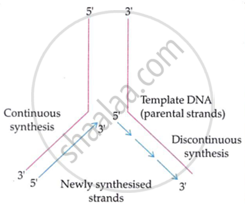Advertisements
Advertisements
प्रश्न
“DNA replication is continuous and discontinuous on the two strands within the replication fork.” Explain with the help of a schematic representation.
स्पष्ट करा
उत्तर
Schematic representation of DNA replication:

Explanation:
- In order to create a replication fork, DNA replication begins at a location known as the origin of replication (ori).
- The separated strands act as templates for the synthesis of new strands.
- DNA replicates in the 5' → 3' direction.
- Deoxyribonucleotide triphosphate, or dNTPs, serve as a substrate and source of energy for nucleotide polymerisation.
- An enzyme called DNA polymerase creates a new DNA strand complementary to the template strand.
- As the complete genome is duplicated, DNA polymerase keeps moving along the template strand and appending new nucleotides to the complementary or expanding strand.
- The DNA polymerase synthesises one new strand (leading strand) continuously in the 5' → 3' direction.
- The other new strand is synthesised in short segments (Okazaki fragments) in the 5' → 3' direction (discontinuous synthesis).
- An enzyme called DNA ligase joins the Okazaki fragments to generate a new strand. This new strand is known as the lagging strand.
shaalaa.com
या प्रश्नात किंवा उत्तरात काही त्रुटी आहे का?
